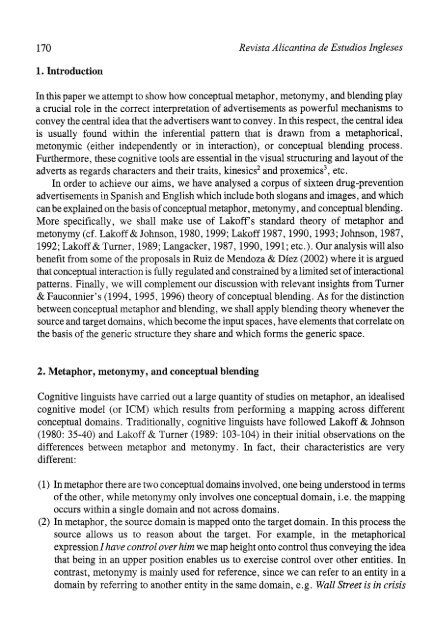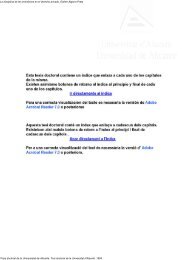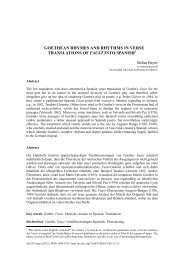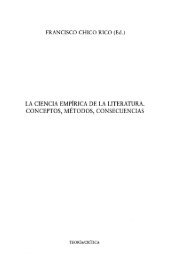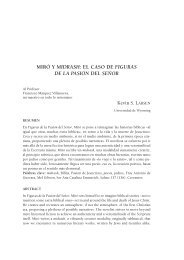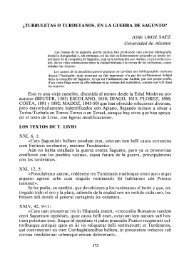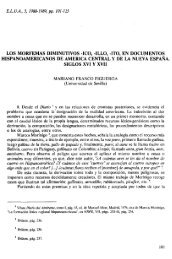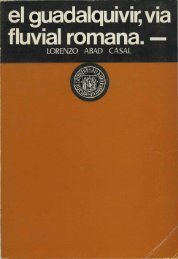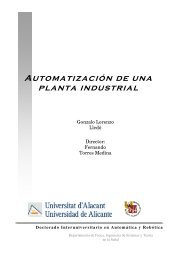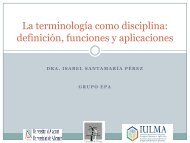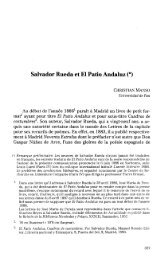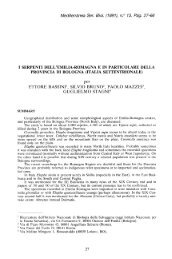The Role of Metaphor, Metonymy, and Conceptual Blending ... - RUA
The Role of Metaphor, Metonymy, and Conceptual Blending ... - RUA
The Role of Metaphor, Metonymy, and Conceptual Blending ... - RUA
Create successful ePaper yourself
Turn your PDF publications into a flip-book with our unique Google optimized e-Paper software.
170 Revista Alicantina de Estudios Ingleses<br />
1. Introduction<br />
In this paper we attempt to show how conceptual metaphor, metonymy, <strong>and</strong> blending play<br />
a crucial role in the correct interpretation <strong>of</strong> advertisements as powerful mechanisms to<br />
convey the central idea that the advertisers want to convey. In this respect, the central idea<br />
is usually found within the inferential pattern that is drawn from a metaphorical,<br />
metonymic (either independently or in interaction), or conceptual blending process.<br />
Furthermore, these cognitive tools are essential in the visual structuring <strong>and</strong> layout <strong>of</strong> the<br />
adverts as regards characters <strong>and</strong> their traits, kinesics 2 <strong>and</strong> proxemics 3 , etc.<br />
In order to achieve our aims, we have analysed a corpus <strong>of</strong> sixteen drug-prevention<br />
advertisements in Spanish <strong>and</strong> English which include both slogans <strong>and</strong> images, <strong>and</strong> which<br />
can be explained on the basis <strong>of</strong> conceptual metaphor, metonymy, <strong>and</strong> conceptual blending.<br />
More specifically, we shall make use <strong>of</strong> Lak<strong>of</strong>f's st<strong>and</strong>ard theory <strong>of</strong> metaphor <strong>and</strong><br />
metonymy (cf. Lak<strong>of</strong>f & Johnson, 1980,1999; Lak<strong>of</strong>f 1987,1990,1993; Johnson, 1987,<br />
1992; Lak<strong>of</strong>f &Turner, 1989; Langacker, 1987,1990,1991; etc.). Our analysis will also<br />
benefit from some <strong>of</strong> the proposals in Ruiz de Mendoza & Diez (2002) where it is argued<br />
that conceptual interaction is fully regulated <strong>and</strong> constrained by a limited set <strong>of</strong> interactional<br />
patterns. Finally, we will complement our discussion with relevant insights from Turner<br />
& Fauconnier's (1994, 1995,1996) theory <strong>of</strong> conceptual blending. As for the distinction<br />
between conceptual metaphor <strong>and</strong> blending, we shall apply blending theory whenever the<br />
source <strong>and</strong> target domains, which become the input spaces, have elements that correlate on<br />
the basis <strong>of</strong> the generic structure they share <strong>and</strong> which forms the generic space.<br />
2. <strong>Metaphor</strong>, metonymy, <strong>and</strong> conceptual blending<br />
Cognitive linguists have carried out a large quantity <strong>of</strong> studies on metaphor, an idealised<br />
cognitive model (or ICM) which results from performing a mapping across different<br />
conceptual domains. Traditionally, cognitive linguists have followed Lak<strong>of</strong>f & Johnson<br />
(1980: 35-40) <strong>and</strong> Lak<strong>of</strong>f & Turner (1989: 103-104) in their initial observations on the<br />
differences between metaphor <strong>and</strong> metonymy. In fact, their characteristics are very<br />
different:<br />
(1) In metaphor there are two conceptual domains involved, one being understood in terms<br />
<strong>of</strong> the other, while metonymy only involves one conceptual domain, i.e. the mapping<br />
occurs within a single domain <strong>and</strong> not across domains.<br />
(2) In metaphor, the source domain is mapped onto the target domain. In this process the<br />
source allows us to reason about the target. For example, in the metaphorical<br />
expression / have control over him we map height onto control thus conveying the idea<br />
that being in an upper position enables us to exercise control over other entities. In<br />
contrast, metonymy is mainly used for reference, since we can refer to an entity in a<br />
domain by referring to another entity in the same domain, e.g. Wall Street is in crisis


